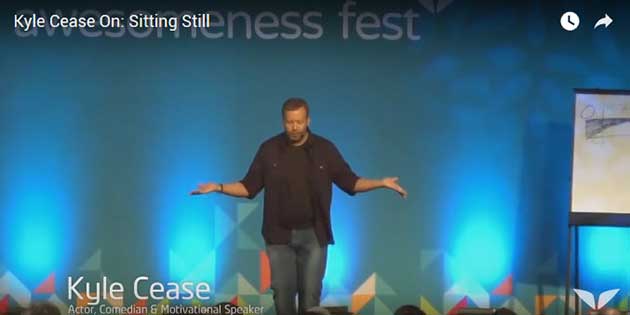The Art Of Mindfulness | Why Mindfulness Matters & How To Practice It

Excerpted from John Parrott’s terrific guide on mindfulness over on his blog at https://relaxlikeaboss.com/the-art-of-mindfulness/ – be sure to check out the full guide there!
Mindfulness has become a bit of a buzzword over the last few years.
In this guide, you’ll learn why being mindful matters and how to practice the art of mindfulness.
You’ll discover how you can enjoy the rewards of being mindful by integrating it into your everyday life.
We’ll also run through five quick mindfulness trainings you can practice at home.
Mindfulness is basically the practice of being consciously aware in the present moment, without judging your experience.
It’s about being ‘mindful’ of every detail in the here and now.
This helps us reconnect with the simplicity of life, by living in the moment.
By achieving this state of awareness, we can enjoy a sense of peace within.
The beauty of this practice is that it can literally transform the way you experience your life.
Five Mindfulness Trainings
If you’re tempted to give meditation a try, then check out the meditation exercises below.
But before you begin, I’d recommend starting off slow.
Mindfulness requires patience and practice – it’s not something we can master overnight.
So take your time and enjoy the experience.
Try to turn some of these exercises into a habit – so that you dedicate time every day to practicing mindfulness.
One Minute Mindfulness Exercise
1. Find a quiet place where you can relax
2. Close your eyes
3. Now bring your attention to where you feel your breath most – it could be your nostrils or your lungs
4. Count each breath for just one minute
5. Every time you get to 10 breaths, reset and count from 1 again
6. When you get distracted, bring your attention back to your breath
The 5 4 3 2 1 Exercise
This exercise can help to quickly bring your awareness back to the present moment.
(No prizes for why it’s called the 5 4 3 2 1 exercise.)
Simply focus your attention on each of the following steps:
1. 5 things you can see
2. 4 things you can feel
3. 3 things you can hear
4. 2 things you can smell
5. 1 thing you can taste
Gratitude Exercise
We often take the little things for granted in life.
This gratitude exercise brings your focus back to the beauty of nature.
So go on a gentle walk and think about the things you’re grateful for.
This could be for the weather, the breeze, or even the flowers you see along the way.
It doesn’t have to be a long walk – 10-15 minutes will do.
Try to soak in every detail of your walk.
You could even pay attention to the ground beneath you or count every step you take.
Five Senses Exercise
This exercise is a little similar to the 5 4 3 2 1 exercise, where you focus on your five senses to bring yourself back to the current moment.
Here’s how it works.

The Self-Compassion Mindfulness Exercise
Being kind to others is great, but sometimes we forget to be kind to ourselves.
So when you’re facing a situation that you find challenging, try repeating a phrase or mantra to yourself that creates a sense of self-compassion.
Examples could include:
“I’m doing the best I can and it’s enough”
“I can feel whole, complete, content and satisfied without needing to do anything”
“May I be kind to myself in this moment”
These mantras are known as positive self-talk.
They’re great for mindfully lifting our mood during times when we’re unkind to ourselves.
Mindfulness Tools
There are plenty of mindfulness tools that can help you along the way.
Of course, none of these are necessary and you don’t need them to be mindful.
But some people feel like they enhance the experience of mindfulness.
So here’s a list of some of the best mindfulness tools:
Mindfulness Cards: Try writing down your favourite mindfulness quotes on cards and then placing them somewhere where you’ll be reminded to focus on the present moment.
Poetry: Poets throughout history have been inspired by mindfulness.
Mindful poems are like a little treasure cove, where you can delve into them whenever you need to.
Meditation Music: Concentrating on music is another form of mindful meditation.
Plus soundtracks such as nature sounds can help to relax and calm your mind.
Mindfulness Quotes: It’s undeniable, quotes inspire us.
Reading quotes from the Dalai Lama or Thich Nhat Hanh are quick sources of inspiration.
Mindfulness Colouring Books: In what’s known as anti-stress art therapy, colouring books combine the concentration of mindfulness with the creativity of art.
Retreats: Taking time out for a retreat might not be ideal for beginners.
But if you’re looking to immerse yourself in the practice of mindfulness, this tool might be ideal.
Workshops: Whilst retreats might be a little heavy, a mindfulness workshop usually only lasts for an hour or two and can help inspire your practice of being mindful.
Workshops are a little more beginner friendly.
Excerpted from John Parrott’s terrific guide on mindfulness over on his blog at https://relaxlikeaboss.com/the-art-of-mindfulness/ – be sure to check out the full guide there!
[/et_pb_text][/et_pb_column]
[/et_pb_row]
[/et_pb_section]
Let’s keep in touch!
Want occasional emails with news, info, and special offers? Enter your best email address below – no spam, promise!






